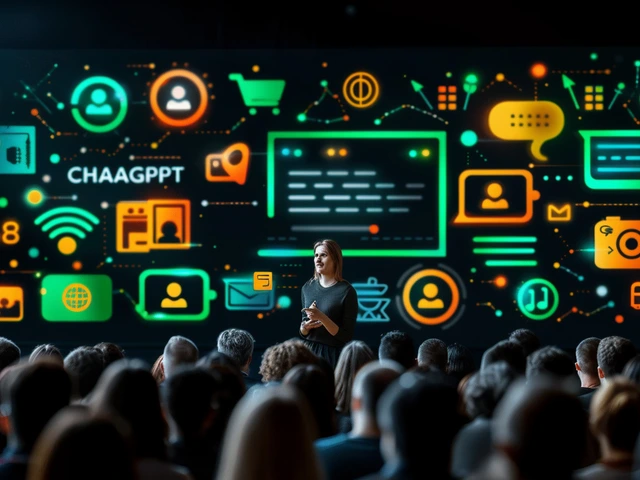
Imagine a tool that not only responds to queries but can also craft compelling advertisements, streamline campaign management, and personalize customer interactions. Enter ChatGPT, a form of artificial intelligence designed to understand and generate human language based on the data it’s trained on. This revolutionary technology is reshaping how businesses approach marketing and advertising.
In today’s digital age, staying ahead involves harnessing innovative technologies. ChatGPT offers a unique advantage by automating routine tasks, providing insightful analytics, and enabling a more personalized customer experience. Let's explore how this technology is setting new standards in the advertising world.
- Introduction to ChatGPT
- Enhancing Customer Engagement
- Streamlining Campaign Management
- Improving Content Creation
- Integrating AI with Traditional Marketing
- Future Trends in AI and Advertising
Introduction to ChatGPT
ChatGPT, developed by OpenAI, is an advanced artificial intelligence that has the capability to engage in conversation by generating human-like text based on the input it receives. This technology, built on the GPT (Generative Pre-trained Transformer) architecture, has been trained on a diverse range of internet text. By doing so, it develops an ability to produce content that can be astonishingly coherent and contextually relevant, spanning multiple languages and styles.
The roots of ChatGPT go back to the development of the transformer model by researchers at Google in 2017. This was a pivotal moment in AI that shifted focus from pattern recognition alone to include capabilities for understanding context in text. OpenAI has since capitalized on this technology with iterative improvements, resulting in ChatGPT’s highly nuanced ability to understand and respond to text prompts dynamically.
A key aspect of ChatGPT’s design is its training process. It involves feeding vast amounts of text data, allowing it to learn a broad spectrum of linguistic structures, phrases, and information. This process, known as unsupervised learning, does not require specific guidelines for each new piece of information. Instead, the model detects patterns and infers context, which enhances its ability to generate intelligent and surprising outputs.
Businesses and individuals alike find ChatGPT to be a formidable tool due to its versatility. Not only is it used to power customer service bots or serve as a virtual assistant, it’s also immensely useful in creating content, participating in discussions, and even helping writers overcome writer’s block. Imagine you’re crafting an email or a marketing copy, and you could use some inspiration or a second opinion; ChatGPT can step in as a collaborative partner.
The real magic of ChatGPT lies in its interaction model. When you provide it with a prompt, it analyzes the input using the patterns it has learned during training. With each interaction, it fine-tunes its responses, often leading to more sophisticated and contextually appropriate replies. This ability is not just a technical marvel but also a significant leap towards more natural and productive human-AI interaction.
What truly sets ChatGPT apart from traditional programmed scripts is its generative nature, which allows it to go beyond static responses to create something genuinely new each time. Whether it’s drafting an article or solving a complex problem, ChatGPT’s responses are often insightful and pointedly relevant, making it an invaluable resource in numerous fields.
Enhancing Customer Engagement
At its core, effective advertising is about connecting with people. ChatGPT plays a pivotal role here by making interactions more dynamic and responsive. Traditional methods often rely on broad strategies aimed at large groups. ChatGPT, however, brings a new layer of sophistication to this. By analyzing vast amounts of data, ChatGPT identifies patterns and preferences at an individual level. This means it can suggest highly personalized advertising messages that resonate deeply with each customer. Such tailored communications significantly boost engagement, ensuring that customers feel understood and valued.
Consider an online retailer using ChatGPT to manage inquiries. Instead of generic responses, ChatGPT can analyze the consumer's previous interactions and purchase history. This enables it to offer personalized product recommendations and special offers tailored to the consumer’s tastes and needs. The immediate impact is a more engaging user experience that can lead to increased customer loyalty and sales. Studies show that a personalized shopping experience can significantly encourage customers to return, potentially increasing revenue by 10-30%.
The integration of ChatGPT isn’t just about direct communication. It also helps in crafting content that engages. For instance, a travel agency could use ChatGPT to generate descriptive and enticing content about destinations based on the most common questions and interests expressed by their clients. This makes the content not only informative but also extremely relevant and engaging for the reader. By maintaining this level of relevance, businesses keep their audience interested and involved, leading to higher engagement rates.
Streamlining Campaign Management
Managing an advertising campaign involves multiple layers, from planning and execution to monitoring and optimization. With the integration of ChatGPT, these processes are not only simplified but also made more efficient. Imagine a world where data collection and analysis are instant, where market trends are identified in real-time, and campaigns are adjusted on the fly. ChatGPT allows businesses to manage their marketing campaigns with unprecedented ease.
By automating routine tasks such as budget tracking, scheduling ads, and reporting, ChatGPT frees up human marketers to focus on strategy and creativity. This shift fundamentally changes the campaign management landscape, making it possible for smaller teams to operate with the efficiency and precision of larger ones. Moreover, because ChatGPT can analyze vast amounts of data in seconds, companies can react swiftly to changing market conditions, optimizing their advertising spend for the best possible returns.
Why Efficiency Matters in Campaign Management
Efficiency isn't just about saving time; it’s about enhancing performance. Consider how quickly competitive landscapes can change. Businesses that can update their advertising strategies in real-time often secure a significant advantage. For instance, if a competitor launches a surprise product, ChatGPT-equipped businesses can immediately craft and deploy counter-advertisements to retain market share. This agility in campaign management is invaluable in today’s fast-paced market.
Furthermore, the accuracy of ChatGPT in understanding consumer sentiment through data analysis allows for more targeted advertising. When you can pinpoint exactly what your audience is interested in, you tailor your messages accordingly, increasing the likelihood of engagement. Here, the capability of ChatGPT to modify ad content to fit different segments of your audience comes into play, making your campaigns more personal and effective.
ChatGPT also introduces an innovative approach to testing marketing strategies. Through A/B testing facilitated by AI, businesses can explore different approaches simultaneously, quickly identifying which variations perform the best. This systematic testing leads to continuous improvement in campaign outcomes, a crucial aspect of modern advertising.
It’s clear that using AI like ChatGPT in campaign management is not just about keeping up with trends, but rather staying ahead of them. The dynamic capabilities of this technology revolutionize how we view and implement advertising strategies, ensuring that businesses are not only reactive but also proactive in their approach.
Improving Content Creation
In the realm of digital marketing, content is king. With the integration of ChatGPT, content creation has taken a leap forward in terms of efficiency and effectiveness. This AI has the capacity to generate a wide range of content, from blog posts and articles to engaging social media updates and informative email newsletters. Its ability to analyze vast amounts of data enables it to produce content that is not only relevant but also deeply tailored to specific audience needs.
Utilizing ChatGPT in content creation transcends the conventional approach. It allows for the consistency in voice and style while handling large volumes of content that might be overwhelming for human writers. Moreover, the speed at which ChatGPT operates can dramatically reduce the time from concept to publication, helping businesses to stay relevant in a fast-paced digital environment. The precision of this technology in picking up subtle nuances in the data translates into more accurately targeted content, appealing directly to the interests and needs of its audience.
Another significant advantage is the scalability that ChatGPT provides. A business can start with a small pilot project, measure its effectiveness, and scale up its content production without the need for proportional increases in human resources. This scalability factor extends to different languages and regional needs, making global marketing campaigns more feasible and less resource-intensive. In essence, ChatGPT democratizes high-quality content creation, making it accessible to businesses of all sizes.
While the benefits are clear, it is crucial to blend human creativity with AI capabilities to achieve the best results. The synergy between human oversight and AI-driven content production creates a balance that enhances brand authenticity while leveraging computational efficiency. For instance, a human editor can ensure that the content aligns with the company's ethical standards and brand voice, factors that are currently beyond AI's full grasp.
To illustrate the effectiveness of AI in content creation, consider its role in data-driven storytelling. ChatGPT can sift through thousands of data points to identify trends that are relevant and engaging for readers. When incorporated correctly, it provides a robust tool for content strategists to expand their creative horizons and deliver compelling narratives that resonate with audiences, drive traffic, and improve engagement.
Thus, the integration of AI into content generation processes promises a new era of marketing where technology and creativity merge to push the boundaries of what's possible in digital advertising. The key to maximizing the benefits of ChatGPT lies in understanding its functionality and deploying it in a way that complements human ingenuity, ensuring content that is not only productive but also genuinely engaging and tailored.
Integrating AI with Traditional Marketing
As businesses seek new ways to innovate in advertisement and customer outreach, the line between artificial intelligence and traditional marketing channels becomes increasingly blurred. Integrating ChatGPT, a cutting-edge AI solution, with longstanding marketing practices, not only revitalizes old methods but also creates synergies that amplify both reach and effectiveness. For instance, incorporating AI-driven insights into direct mail campaigns can significantly enhance personalization and response rates, moving a once static strategy into a dynamic interaction tool.
In many scenarios, marketing teams use AI to analyze big volumes of customer data. This not only speeds up the decision-making process but also ensures that the campaigns are more tailored and relevant to each segment. For example, an AI can segment audiences with unprecedented precision, thereby enabling marketers to craft messages that speak directly to the audience's preferences, needs, and behaviors. This level of customization was once the remit of digital platforms alone but is now permeating more traditional marketing avenues like television and print media.
While some marketers may fear that AI could overshadow the human element in creativity and emotional connection, the reality is quite the contrary. Smart integration of AI allows marketing professionals to spend more time on creative strategy and impactful storytelling because they're spending less time on data-heavy tasks such as audience segmentation and campaign analysis. Integration of AI not only conserves resources but also scales marketing efforts efficiently, proving to be a game-changer in the constantly evolving market landscape.
For those businesses already seeing success in their traditional marketing channels, the thought of integrating AI might seem daunting. However, transitioning isn't just about leveraging new technology but also about marrying it with what already works. It’s about enhancing the current strategies with AI's capabilities to make them not only better but also more cost-effective and data-driven. This approach ensures that the company preserves the original brand messaging while innovating on execution.
Take, for example, the case of a well-known retail chain that integrated AI tools to analyze customer purchase history and feedback. Leveraging these insights, they were able to craft personalized email campaigns that reflected the individual customer's preferences and prior interactions with the brand. The result was a measurable uplift in customer engagement and sales. Thus, proving that AI can serve as an invaluable partner in refining and enhancing traditional marketing strategies to resonate better and perform stronger in today's digital age.
Future Trends in AI and Advertising
As we delve into the realm of possibilities that artificial intelligence (AI) presents for the advertising industry, it's pivotal to understand the trajectory of these technologies. AI is swiftly evolving from a helpful tool to a central player in creating and curating content that resonates with audiences on a personal level. Experts predict that the influence of AI in advertising will only grow, making businesses more reliant on it to understand and appeal to their target markets. Specifically, the rise of predictive analytics and machine learning can enable advertisers to anticipate consumer needs and behavior more accurately than ever before. This capability will likely result in more efficient use of advertising budgets and higher conversion rates.
Another trend that's shaping the future of this intersection between AI and advertising is the increasing focus on privacy and data protection. With regulations like the GDPR in Europe and similar laws in other regions, advertisers must navigate the complex balance between personalization and privacy. AI can help here too by developing smarter systems that provide personalized experiences without overstepping privacy boundaries. Techniques like federated learning, where AI systems learn from decentralized data, could potentially revolutionize how data is handled in the industry without compromising user privacy.
In addition to privacy-centric advancements, the growth of voice and visual search as part of AI's capabilities will likely redefine the ways in which brands reach their audiences. Devices enabled with voice recognition, like smart speakers, are becoming ubiquitous, and advertising strategies will need to adapt to this reality. Visual search technology, too, is making its mark, allowing users to search for products and services simply by snapping a photo. Advertisers might start focusing more on these technologies to meet customers in their moment of need.
The future also promises more collaboration between AI and traditional creative efforts in advertising. It's becoming increasingly clear that AI can enhance human creativity, not replace it. By analyzing vast amounts of data and providing insights, AI can inform more effective creative strategies. For instance, machine learning algorithms can suggest which color schemes or music might evoke the right emotional response from an audience, aiding creative teams in their decision-making processes.
As we look towards a future where AI is e...








Write a comment